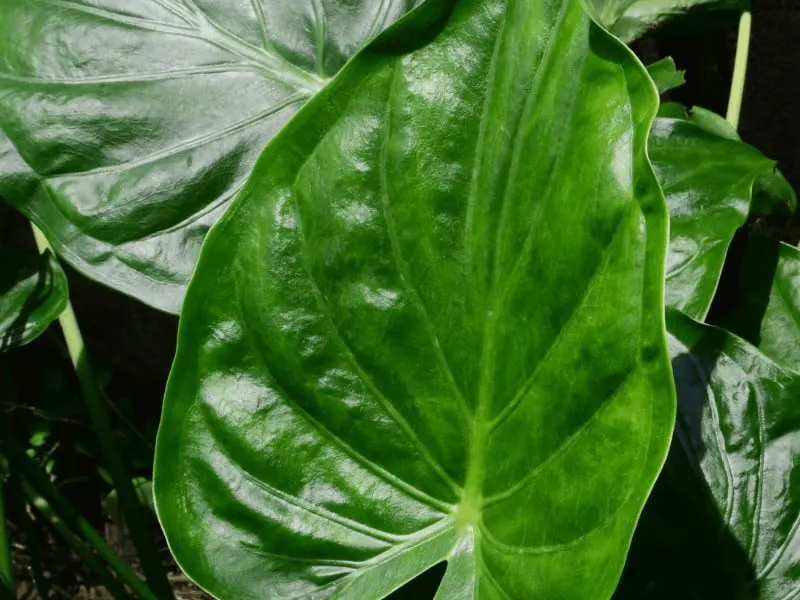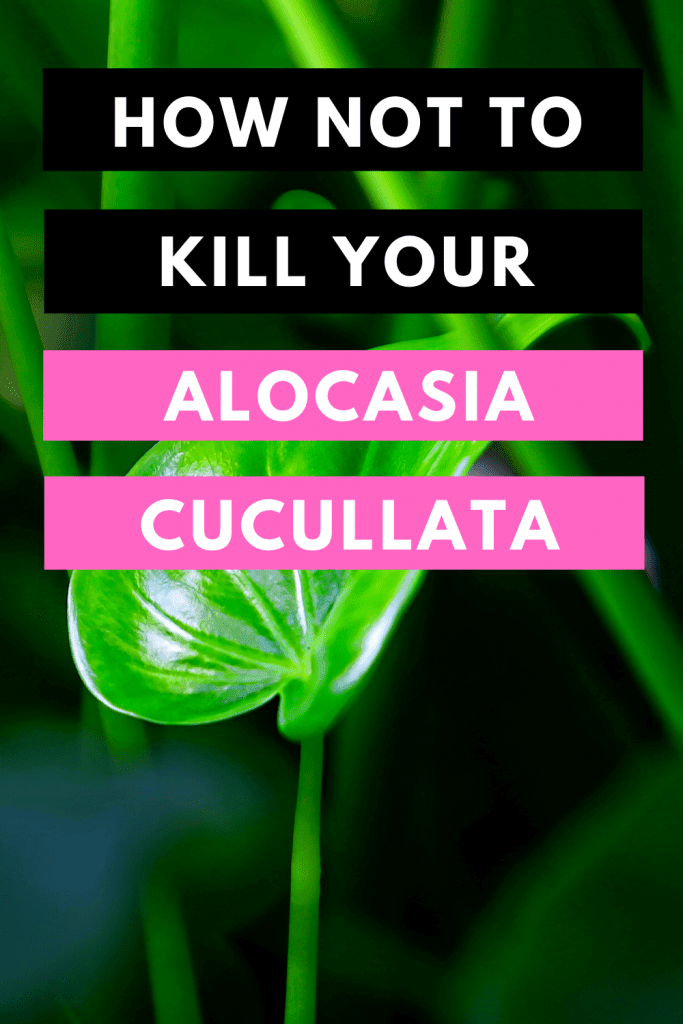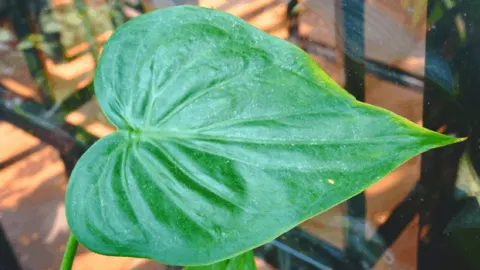The Alocasia cucullata plant, nicknamed ‘Buddha’s Palm,’ is a famous houseplant choice. It has earned this unique name because of its slender stems attached to large heart-shaped leaves that seem to be waving with the slightest of breezes.

Alocasia cucullata Takeaways
| Species | Alocasia cucullata |
| Synonyms | Chinese Taro,Hooded Dwarf Elephant Ear,Buddha's Hand,Chinese Alocasia |
| Family | Araceae |
| Genus | Alocasia |
| Growth | Compact, Clumping |
| Height | 2 feet |
| Width | 2 feet |
| Soil | Well-draining soil mix |
| Watering | Every 7 days |
| Light | Bright Indirect |
| Temperature | 65-85 °F (18-30°C) |
| Humidity | 50-80% |
| Fertilizer | Fertilize bi-weekly in spring and summer |
| Propagation | By division |
| Toxicity | Toxic to animals such as cats and dogs, and humans. Contains calcium oxalate crystals. Can cause mouth pain, nausea, vomiting, and diarrhea. |
Table of Contents
The Alocasia cucullata Plant
The Alocasia cucculata is a tropical species belonging to the Araceae family’s Alocasia genus (Aroids). They are also known as Elephant Ear plants. The Cucullata species is smaller than its fellow members, making it an ideal houseplant choice.
These plants are native to Southeast Asia’s tropical rainforests and grow abundantly on Borneo, the largest Asian island. Alocasia has approximately 79 known species.
Originally, the Alocasia plants were edible. However, many inedible varieties have now been bred for decorative purposes.
The leaves of the Alocasia Cucullata are usually dark green with a beautiful glossy appearance. The plant gives rise to dense foliage, all bunched close together. The Cucullata plants are available in various sizes and can reach different heights, the maximum being 60 inches (152 centimeters).
The Alocasia Cucullata plant is believed to bring good luck. Therefore, it is often grown in Buddhist temples across Thailand. Undoubtedly, its lush green foliage can make any place look like a haven of peace and rest.
Alocasia cucullata Care
The Cucullata plant thrives in bright, dappled sunlight. It requires humidity between 50-80%. Keep the temperature between 65-85 degrees Fahrenheit. They grow best in well-draining soil. Water every seven days.
This evergreen plant is durable and easy to care for. It is easy to plant outdoors or indoors in containers.
The Alocasia Cucullata plant has been a popular indoor houseplant choice due to its ornamental and vintage vibe. It is often found hanging from baskets in offices or living rooms of houseplant lovers.
These tropical beauties are easy to manage and will not have you fussing over them. They need conditions that are mostly present in average households.

Caring for an Alocasia cucullata Indoors
Soil
The Buddha Palm plant grows well in loose, well-draining, and slightly loamy soil.
Do not keep the soil excessively moist, as it will increase the probability of infection.
I suggest you use organic and well-aerated loose soil with a considerable amount of peat moss. Add some perlite or builder’s soil if you think the planting soil is too heavy.
Allow the soil’s top 1 to 2 inches (2.5-5cm) to dry out before you water your Cucullata plant. This will maintain the necessary moisture and reduce the possibility of fungal infection.
The ideal soil pH for this tropical species is 5.5 to 6.5 (slightly acidic). The soil’s acidity enables the plant to absorb the nutrients more efficiently. The potting mix should preferably be well-draining and crumbly loam.
Ensure the soil is not too dry or wet, and your Alocasia Cucullata will grow a happy plant.
Watering
Watering once a week is sufficient in environments similar to the Buddha’s Palm plant’s natural habitat. However, its needs may change depending on the season and its environment. You can wait for the above 2 to 3 inches of the soil to dry out before adding water.
In winters, the plant is mostly dormant so water your Alocasia cuculata only when needed. Try to evenly water the Cucullata plant, so that the water is accessible to all parts. Like for other plants, over-watering exposes the Cucullata plant to various infections.
The infection can present itself in the form of wet leaves, root-rot, discolored leaves, and more. This can be an absolute nightmare for houseplant owners. To prevent such mishaps, water your Cucullata plant moderately till its soil is soggy, but not wet.
Monitor your Alocasia Cucullata plant’s soil to determine whether it needs water or not. An excellent characteristic of the Cucullata plant is that small droplets form on its leaf tips when it receives excessive water. This helps drain the unnecessary moisture.
However, this water can be irritating for the human skin and harmful for pets. Therefore, it is best to wipe it off carefully with a cloth.
Light
The lighting needs of the Alocasia plants are pretty simple. Like most plants, this tropical species enjoys bright, filtered sunlight. However, it must not be too direct as it can lead to leaf scorch.
Pot your Cucullata where dappled indirect sunlight hits it. You can place it close to a window or just inside your balcony door. Make sure the light coming into contact with it is not too harsh.
Before purchasing a Cucullata plant, you can enquire if it is sun-trained. Such plants can often tolerate relatively harsher sun rays and produce leaves that are greener than the average.
However, do not force your plant to grow in unfavorable lighting conditions. A healthy plant with fairly green leaves is much better than a dehydrated and wilting one.
If you notice your plant growing leggy stems or moving excessively towards one side, chances are it is trying to grow towards a brighter spot. In such a scenario, change your Cuculatta plant’s location and place it in a sunnier and partially-shaded spot.
Temperature
Alocasia Cucullata is a pure tropical jungle species. As expected, this tropical beauty loves warm temperatures. Its ideal temperature range is 64 to 72 degrees Fahrenheit (18 to 22 degrees Celsius).
Most typical households are within this temperature range. This makes it relatively easy for the Cucullata plant to thrive and grow. As long as you keep your Cucullata plant away from direct drafts of air, for instance, from air conditioners and heaters, it will develop well.
However, if you live in an area with extreme temperatures, it is best to keep the Cucullata plant indoors. Though durable, it cannot stand unfavorable conditions for too long. If kept in temperatures below 60 degrees Fahrenheit, it can shed all its leaves.
The Alocasia Cucullata is a temperature-sensitive plant. Therefore, keep a close eye on the temperature you keep your Cucullata plant in.
Humidity
The Alocasia Cucullata plants grow best in high humidity levels. The ideal humidity range for a Cucullata plant is 65% to 80%. Make sure it does not fall below 60%, as it may lead to dried-up leaves.
As much as they love humidity, ensure that you do not provide excessive moisture to the plant, for example, by misting the plant regularly. Such high levels will increase the plant’s susceptibility to infection and disease.
However, make certain that you maintain a humidity level that is high enough for the plant to grow in easily. If your area’s humidity is too low, put your Alocasia Cucullata plant on a tray that is filled with pebbles and water. Add water till it is just below the plant’s roots, but is not touching them directly.
If you are a fan of gadgets and technology, you can use a humidifier to raise the humidity to the desired level.
You can also mist its surroundings with lukewarm water to attain the preferred humidity level. Alternatively, you can group all your houseplants.
Fertilizer
Feed your Cucullata plant every two weeks or twice a month, especially from late March to September, with a good-quality fertilizer.
The Alocasia Cucullata plant’s food needs are similar to its size, large.
You can also feed it with a slow-release fertilizer or a diluted liquid fertilizer. However, please do not feed the plant during the winter season as it has no active growth during this time of the year.
Be careful not to over-fertilize your Alocasia Cucullata plant as it may cause accumulation of unnecessary salts, which eventually leads to burnt leaf tips.
Repotting
The lush, green, heart-shaped foliage of the Alocasia Cucullata looks excellent as it is. However, to enhance its beauty, you can pot it into fancy containers and baskets. The Cucullata plants like to be root-bound; thus, a container that just fits its roots is the best for repotting it.
You only need to repot the Cucullata plant once a year. Let its roots remain slightly crowded to ensure healthy growth. Repot it at the start of the growing season of summer and spring.
The plant does not actively grow during the colder seasons. Thus, you do not have to repot it during this time.
Pruning
The Alocasia Cucullata is a relatively large plant. Unless you have plenty of space for it to grow, it can be a problem. Therefore, it may require pruning for size control from time to time.
Grab a pair of pruning scissors or shears and prune 1 to 2 vines of the Cucullata plant carefully. Cut the bottom leaves, preferably as new leaves often form at the top.
You can also cut off the yellow and dead-looking leaves as they can look unpleasant. They may simply have this appearance due to old age or fungal infection.
Pruning off yellow and dead leaves will not only make your plant look more delicate and beautiful, but will also decrease the probability of spread of disease if present.
Please make sure you sterilize your gardening equipment before using them on any of your plants. This minimizes the transfer of infection and disease.
Alocasia cucullata Propagation
The ideal propagation method for Cucullata plants is by splitting the rhizomes. The Alocasia Cucullata plants grow from rhizomes in the ground.
I would suggest you propagate this tropical species during spring or right before the start of summer. This is the period when the Cucullata plant is just coming out of its winter dormancy phase.
Before propagating, make sure your gardening tools are clean and disinfected. Use rubbing alcohol to get rid of germs and prevent the spread of infection.
Rhizome Method
Follow the guide below to propagate a Cucullata plant:
- Prepare a potting mix containing organic, well-draining soil and collect water that does not contain chlorine.
- With the help of a shovel, carefully dig around a mature Cucullata plant.
- Now lift it out of the ground.
- Ensure that you dig a minimum of 12 inches around the plant to prevent damaging its roots or the rhizomes.
- Next, gently take the plant out of the soil entirely and remove the excess soil away from the plant and roots.
- You will see some long tubers just below the ground where the Cucullata plant was growing.
- Divide each of these tubers. Mostly, the tubers are easy to divide. However, if you face difficulty, use a clean knife or a pair of scissors to separate them.
- Now, in a container, place one of the tubers and settle its roots right.
- Fill this container with water. If you have chlorinated water only, let it sit for 24 hours before adding it into the potting mix.
- Firm this mixture with your fingers. Make sure there is not excessive water in the container.
- Place this container in a well-lit spot that receives plenty of bright dappled sunlight.
- Top up the water whenever needed and wait for the plant to grow.
- You can also add a dash of liquid fertilizer to promote growth.
Lastly, patiently wait for the plant to grow. It may take up to a few weeks for it to mature. You can place the Cucullata plant in small pots as it likes being slightly root-bound.
Alocasia cucullata Flower
The Alocasia Cucullata produces small white or cream-colored flowers during the summers. However, they are inconsequential compared to the plant’s lush green leaves. It is grown for its unique foliage mostly.
Growth
The Alocasias Cucullata species gives rise to large heart-shaped leaves. It grows mostly during the summer and spring seasons and becomes dormant during late fall and winter.
The Cucullata plant may grow up to 13 feet (4 meters). They are fast-growers. They usually drop old leaves quickly but are equally quick to grow new foliage.
Provide it with its ideal growing conditions to help it reach its maximum potential in terms of height and overall growth.
Common Problems for Alocasia Cucullata
Xanthomonas
A common disease for this plant is Xanthomonas. It is present as black or dark brown spots on the leaves upper or lower side and a yellow-colored rim around the said spots.
This can be avoided by watering the plant only when it is needed. Similarly, please do not drench its roots in water, as that will also increase the possibility of fungal or bacterial attack.
Sun Damage
The leaves of the Alocasia Cucullata plant may begin to scorch if placed in direct sunlight. Do not put your Cucullata plant in harsh sunlight. It is best to place it indoors. Grow it outdoors only in a partially shaded spot.
You can also put it outside in the late evening or early morning sun if the sunlight is not too direct.
Pests and Diseases
The common pests on Alocasia plants include aphids, mealybugs, spider mites, and scale. To prevent an attack, use insecticidal spray or soap every few weeks. This will also help the plant stay dust-free.
In case of infestation, get yourself ultra-fine insecticide oil or Neem oil. This will help get rid of the pests and their eggs.
Floppy/Yellow Leaves
The Alocasia may naturally drop some yellow or floppy leaves. This is mostly normal because the Cucullata plant can only hold a certain number of leaves at any one time. Additionally, this can also be a way for it to manage and distribute nutrition to the plant’s new foliage.
However, if it is dropping an abnormal amount of leaves from various locations, it may be alarming. Check if you are over or under-watering your plant or change its location to a brighter spot with dappled sunlight.
The Alocasia plants may suffer from other diseases such as leaf-spot and crown, stem, and root-rot. Avoid overwatering your plant and ensure good air circulation around the plant to prevent the occurrence of these diseases.
Tips for Growing Alocasia Cucullata
- The Cucullata plant often sheds a leaf when it grows a new one. It is normal; thus, do not panic.
- Water the Cucullata plant with room-temperature water.
- Grow the plant in wet, well-draining potting soil mix with sufficient nutrients.
- Let it be slightly root-bound for healthier and faster growth.
Alocasia Plants
Some popular Alocasia plants are:
- Alocasia polly
- Alocasia zebrina
- Alocasia micholitziana ‘Frydek’
- Alocasia macrorrhizos
- Alocasia odora
- Alocasia cuprea
- Alocasia wentii
- Alocasia reginula
- Alocasia cucullata
- Alocasia azlanii
Frequently Asked Questions
Why are my Alocasia Cucullata plant’s leaves drooping?
The leaves may be drooping due to insufficient light or over/under-watering. Reconsider your recent care and adjust your watering schedule. Follow the care guide above and water only when needed.
My Alocasia Cucullata has lost all its leaves! Should I throw it out?
Do not throw your Cucullata plant immediately. Give it some time and extra attention, and it may just develop its lush green leaves back and begin to grow normally.
Why are there spots on the leaves of my plant?
The Alocasias are sensitive to salts and chlorine in the water, which may cause spotting. Let the water sit in a bucket for approximately 24 hours before giving it to the plant. Alternately use distilled water.
How often does my Cucullata plant need to be repotted?
Repot it approximately after 12 to 18 months. However, the Cucullata plants prefer to be root-bound so, do not rush.
Why is my Alocasia Cucullata plant dying?
You may be overwatering your plant due to which its soil is completely saturated. Keep the soil moist but not saturated and water it only when needed. Moreover, follow the guide above for the best care.
Conclusion
The Alocasia Cucullata is an evergreen tropical plant. It can be placed in houses, offices, or commercial buildings. Its glossy heart-shaped leaves can make any dull corner look vivid and lively. Provide it with ideal conditions, and your Cucullata will stay healthy and happy.
However, its leaves contain oxalate crystals and so it can be toxic if ingested. It is a gastrointestinal irritant and can cause upper respiratory swelling. Therefore, keep the plant away from children and pets as it may cause breathing problems.


